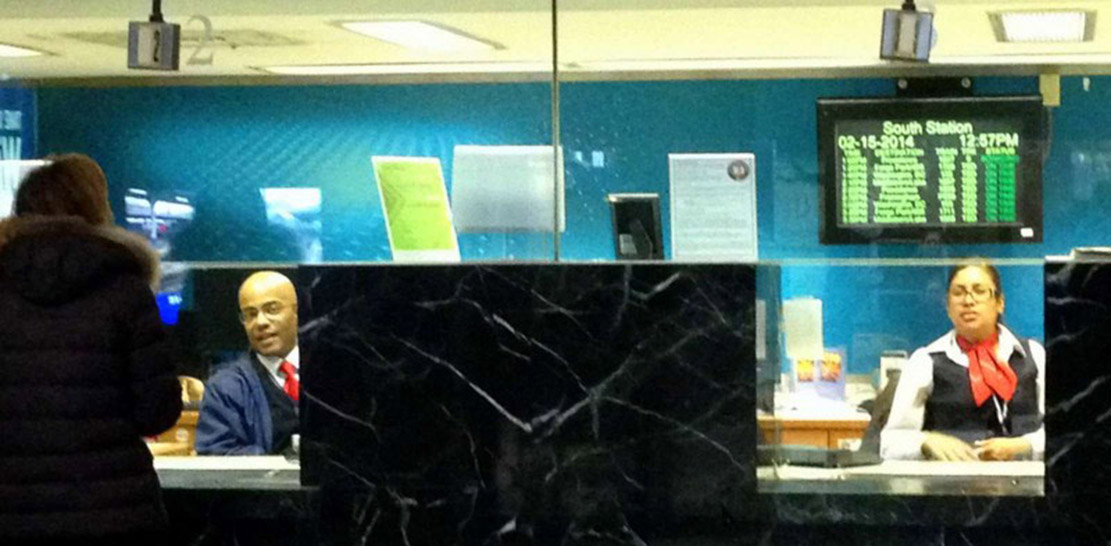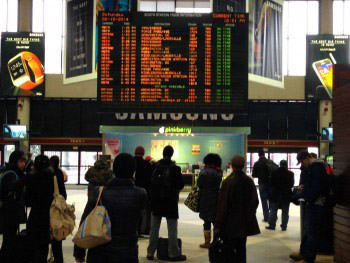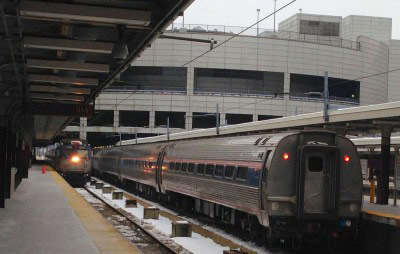Closer to Home

March 21, 2014 / Going By Train
When I was a kid, I used to listen to special radio programs on Saturday mornings. None was more gripping than “Grand Central Station”. It was, I suppose, a sort of anthology of stories about New York City. I don’t remember any of them. But what I do remember, now about 65 years later, was the thrilling introduction to each program. Exciting train sounds, with a voice-over describing the approach of the train to Gotham:
(locomotive whistle)
(rapidly, and in a hushed voice)
As a bullet seeks its target, shining rails in every part of our great country are aimed at Grand Central Station, heart of the nation's greatest city. Drawn by the magnetic force of the fantastic metropolis, day and night great trains rush toward the Hudson River, sweep down its eastern bank for one hundred and forty miles, flash briefly by the long red row of tenement houses south of 125th street,
(bell begins and continues)
dive with a roar into the two and a half mile tunnel which burrows beneath the glitter and swank of Park Avenue, and then. . .
(bell and crash of brakes)
(majestic voice. . .)
Grand Central Station! . . .
(normal voice)
crossroads of a million private lives, gigantic stage on which are played a thousand dramas daily.

I’ve always been a train nut. Or “rail fan” as it is usually called. I was one month old on my first train trip, and I haven’t stopped.
I have powerful train memories from early childhood, on the way from Denver to Chicago: seeing the sun rising red and low through the doghair forest outside of Burlington, Iowa; being wakeful deep in the night as we stopped, briefly, at tiny stations where people waited on dimly-illuminated platforms for their disembarking family, or waited to board the train, there in the night—and then one or two people would come silently down the darkened aisle of my car, in the blue light, and find a seat. I remember being mesmerized by the apparent two-way movement of the landscapes seen from my window: the near things rushing backwards, the far things creeping forwards. They still do that.
At dinner in the California Zephyr dining car the waiters brought “silver” finger bowls, on their doilied plates, to the tables, and I knew what to do with them. I always ordered the luscious chicken salad, and placed the heavy napkin in my lap. I conversed with the strangers seated at my table. In the morning, speeding across the plains at the breakfast table, I filled my coffee cup from the silver pot and watched the Rockies appear on the horizon like a cloud bank.
When I was sixteen, traveling alone on the Chicago Zephyr, I sat next to a man who’d graduated from college right before I was born. One thing led to another—we talked about geology! what could be more romantic (she is serious here)-- and we spent a magical night in the deserted dome car, watching the signal lights change along the track, half in love for a few hours. When we came back to our regular seats in the morning, the priest sitting behind us glared at my gentleman friend. But he really was a gentleman, and he kissed me goodbye, chastely, in front of my father who came to collect me from the train when we arrived in Denver.
My father tipped the porter TEN DOLLARS to take care of me when I first went off on the train to college. The porter was mindful of his charge: my car was wakeful and noisy and around ten p. m. he came and fetched me and brought me to a silent car, lit softly with blue. Once at college, in Ohio, I found that the train station was a few blocks from my dorm, and I used to go down there and hang out watching the trains come in, when I couldn’t stand another minute at the desk. The engineers would wave, and I wanted to go with them.
As a young single mother needing some respite time, my parents treated me to a small trip from Denver to Glenwood Springs, a spa-like place with hot springs 9,000 feet up in the Rockies, which in order to reach the train had to pass through the famous Moffat tunnel, over six miles long under the mountains. It’s been there since 1928. Being lonely and shy at the spa, I spent a lot of time down at the train station, watching the trains roll out of the tunnel. Clang! Clang! Clang! The heart beats faster.
In 2001, my husband and I had a trip planned, by plane of course, out to California to see relatives. Then 9/11 happened. We were booked on That Same Flight Number. “I think I can do it,” I quavered to him. But in the end we took the train, Boston to Albany, to Chicago, Kansas City, Albuquerque, Flagstaff and Los Angeles. We met many others who had bagged flying to take the train. I’d wondered whether the impact of the planes was as great out in the west as it was in New England. But how heartening: all along our way American flags hung on the fences facing our tracks. Our comrades in the lounge and at dinner shared their stories. We all had stories to tell. I guess we still tell them.
Pronghorn antelope ran outside the windows of our little bedroom, and once a coyote, and, once, some genuine cowboys on their horses. I bought Navajo jewelry from a couple whose “store” was a bus parked trackside at the Albuquerque station, a longtime tradition going back to the heyday of Western train travel.
Even little trips, such as Boston-NYC and return, thrill me, no matter how often I make them—that first instant of departure! Nothing like it! I bring a book but never read it, preferring the landscape as it unscrolls before me.

The old line names still roll nicely on the tongue:
CB&Q (Chicago Burlington and Quincy)
Penn Central
SP (Southern Pacific)
Great Northern
B&O (Baltimore and Ohio)
Rock Island
D&RGW (Denver Rio Grande and Western)
UP (Union Pacific)
BNSF (Burlington Northern and Santa Fe)
ATSF (Atchison Topeka and Santa Fe)
Yes, passenger train travel has been up and it has been down.
In 1830, there was a grand total of 23 miles of railroad track in our young country, and passenger accommodations were more in the form of horse-carriages. No dining cars here! Twenty years later track had increased to nine thousand miles, and by the time of the Civil War, rails transported soldiers and materiel—and sometimes the remains of the fallen.
Recognizing the increasing importance of the railways, in 1862 Congress called for a trans-continental railroad, just in time to make use of the newly-invented Pullman sleeping cars. A Pullman car made up part of the funeral train that carried the assassinated President’s body, as it rolled slowly between Washington, D. C. and Springfield, Illinois over a period of thirteen days in the spring of 1865. The demand for the Pullman cars rose rapidly after that.
The Golden Spike joined rail lines from east and west at Promontory, Utah in 1869 and by the turn of the 20th century nearly 200,000 miles of rail united all parts of the country.
But on the horizon, also at the turn of the century, some faint warning lights. A couple of guys made an amazing journey across the country by AUTO, sleeping in tents sometimes. It took them sixty-five days. In the same year (1903), Ford began mass-producing those autos. And a couple of brothers down in Kitty Hawk did an audacious thing as they took to the skies, just barely.
Train track reached a peak in 1916, with 254,000 miles snaking across the country. However, writings of doom snaked across the wall, too: in 1926, 5,800 brave folks rode in aeroplanes!
Passenger train travel was also at its peak a few years later in 1920, when 1.2 million people used nine thousand intercity trains on those 254,000 miles of track to travel 47 million passenger miles. But this high water mark was at first slowly and then rapidly eroded, first by air travel and then by the great interstate highway system.
World War II called for a great reliance on trains for both freight and human transport. Those were the days when the trains were so crowded that you might have to stand between New York and Chicago.

But then came two mortal wounds. 1952 saw that great American invention, the motel chain (Holiday Inn was the first), followed by the beginning of the interstate highway system in 1956. Along in here, around 1950, 16.7 million people flew in airplanes. So much quicker, you know, than the train, and you dress up for it, and have your meals served to you on little trays by those pretty stewardesses. Miles of railroad track in service dropped to 224,000, and continued to drop.
In 1971, the National Railroad Passenger Corporation came to the rescue. Twenty big rail lines joined, accepted federal monies, and became Amtrak. It was thought that this would be a short-lived affair—nobody wants to ride trains anymore, do they? Yes? They do?
Nowadays, Amtrak operates in 46 states, running about 350 or more trains a day. In 2013, 31.6 million people rode those trains, much as my husband and I plan to do next year. We are making a circuit of the US by train.
We’ll start in Boston and go on down to New York City, where we’ll pick up The Cardinal. We’ll settle into the first of our little rooms and spend the next twenty-four hours or so heading south and west, passing through Washington DC, Virginia and West Virginia, touching on Kentucky and then going on through Ohio and Indiana before arriving in Chicago.
There we board the California Zephyr for the leg out to the far west. I’ll get to pass once more through Burlington, Iowa (I bet that doghair forest is gone now), and Ottumwa, and McCook, Nebraska (familiar names from my childhood train trips). There’ll be a brief stop in Denver, my childhood home, and then on west through that Moffat Tunnel under the mountains, into Utah and Nevada, finally arriving in San Francisco two nights later.
We’ll spend a couple of nights in San Francisco and then fly to Los Angeles, where we take the fabled Sunset Limited across the far south of Arizona, New Mexico and Texas before coming to New Orleans. Of course we’ll spend a couple of nights there, too.
Then the home stretch, on The Crescent bound for New York. Mississippi, Alabama, Georgia, South Carolina, North Carolina, Virginia, and on to Washington, New York, and home again.
Along the way, we’ll listen to narrative by park rangers and local historians, socialize with fellow passengers in the lounge and dining car, take pictures, read and write and stare raptly out the window. We’ll take naps in our cozy room, sleep on crisp sheets as we pass across the land, and, perhaps wakeful, gaze at moonlit landscapes.
Trains carry their own time with them. A time out of time. A time at once slow and fast. A time marked only by changes in landscape and by darkness and daylight. What could be finer? Maybe I will see you there, on the train.
